








TheCrazyHorseMemorial®isdevotedtosupportingNativestudents,artists,andcommunities.Throughour museumsandculturalprograms,weenhancethelivelihoodsofnumerousNativeperformers,artists,speakers, andculturebearers.MemorialconferencespaceisfrequentlyutilizedbyNativeAmericanorganizations, includingNationalIndianHealthBoard,NativeWellness,StrengtheningtheCircle,GatheringIndigenousWays, FirstNationsGathering,andmore.
Duringtheholidayseason,theMemorialconductsfundraisinginitiativestoensurethatchildren residingon SouthDakota’sPineRidgeIndianReservationreceivegiftsandessentialwinterclothing.Wealso consistently supportTheCheyenneRiverYouthProject'sWoOtúh’anWiToyDriveontheCheyenneRiverSiouxReservation, andhostamealwhileprovidingrespitefortheyouthrunnersoftheFtRobinsonOutbreakSpiritualRun, honoringtheirancestorsbyrecreatingtheirpathtofreedomfromFtRobinson,NEtoBusby,MT.Wealso welcomehundredsofstudentsfromreservationschoolsinSD,ND,WY,andMTforeducationalfieldtripseach year. InadditiontoofferingfullscholarshipstoallstudentsatTheIndianUniversityofNorthAmerica®,we providescholarshipstoNativestudentsenrolledinregionalcollegesanduniversities,havingdistributedover $2millioninscholarshipfundstodate.
OurdedicationextendstovariousNativecauses,includingartexhibitsandinitiativesthatraiseawarenessand promoteactionregardingissuessuchasMissingandMurderedIndigenousWomen(MMIW).Wehaveserved lunchtoapproximately120MMIWridersandguests,providedconferencespaceforspeakers,anddisplayed thetravelingMMIWexhibitionwithinourcomplex.Thisexhibit,designedtosymbolizethemedicinewheeland incorporatethefourcardinaldirections,showcasesphotosandstoriesfromMMIWinitiativesacrosstheU.S. andCanada.IncollaborationwithsponsorslikeCrazyHorseMemorial®,theannualMedicineWheelRide successfullyraisesfundsforIndigenouswomen’scharitiesbasedinRapidCity,SouthDakota.
Forover20years,TheCrazyHorseMemorial®EducatoroftheYearAwardhasrecognizedanindividualwho hasmadenotablecontributionstoNativeAmericaneducationinthepastyear.Theawardincludesa$1,000 granttobeawardedtoanorganizationoftheEducatoroftheYear’schoosing,providedtheorganization supportsindigenousstudents.TheawardisannouncedannuallyduringtheNativeAmericans’DayCelebration attheMemorial,whereguestsenjoyafulldaydedicatedtolearningaboutandhonoringIndigenouspeoples, alongsideacomplimentaryTatankaStewmealprovidedinpartnershipwithLaughingWaterRestaurantand CusterStatePark. ThefirstNativeAmericans’DayinSouthDakotawascelebratedatCrazyHorse Memorial®,whereGovernorMickelsonandIndigenousleadersspokeattheeventabouttheneedfor reconciliationandharmonybetweenallpeople.
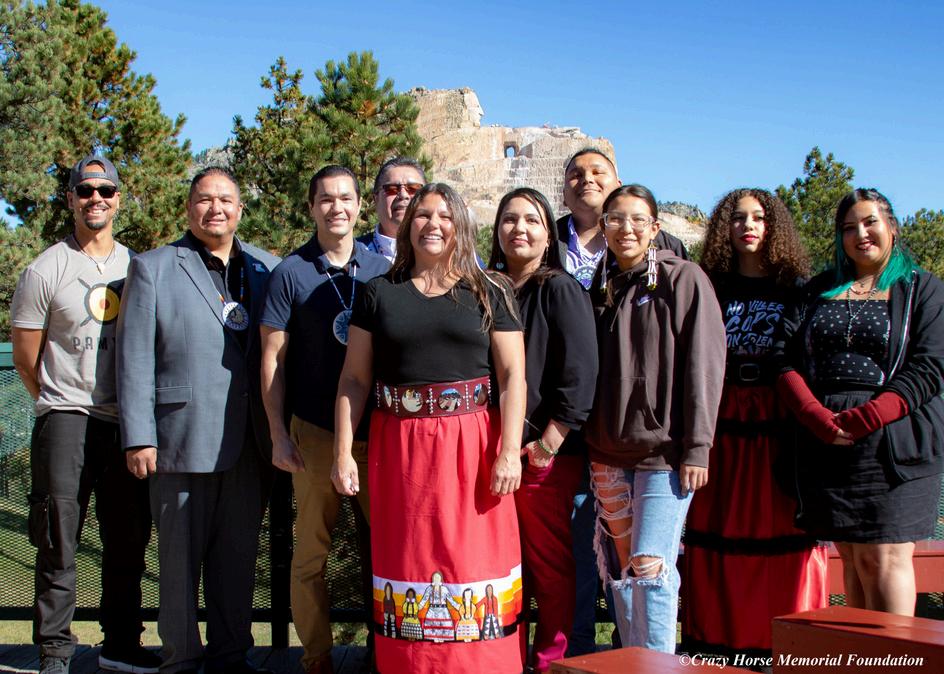




In 1933, Lakota Brule Henry Standing Bear learned of a monument that was to be constructed at Ft Robinson, Nebraska to honor his maternal cousin, Crazy Horse, killed at Ft Robinson in 1877. Standing Bear wrote to James Cook who was steering the planned project, sharing with Cook that he and many of his fellow Lakota leaders had formed the Crazy Horse Memorial Association and were promoting a carving of Crazy Horse in the sacred Black Hills. Standing Bear explained that as a relative of Crazy Horse, it was culturally appropriate for him to initiate such a memorial to his cousin. In addition, Standing Bear believed strongly that the Black Hills, because of the spiritual significance to the Lakota people, was the only appropriate place for such a memorial. These two beliefs would finally lead Standing Bear to search for a skilled artist who could take on the task. At one point, he even approached Gutzon Borglum to advocate for an Indigenous addition at Mt. Rushmore. He eventually learned of a sculptor named Korzcak Ziolkowski after reading of Ziolkowski’s first place win at the World’s Fair. After years of correspondence and delays due to war, illness, and other distractions, the two were finally able begin work on what is now known as the world’s largest mountain carving in progress.
But Crazy Horse Memorial was never meant to be just a mountain carving. Standing Bear, the original dreamer, always saw the project as a full humanitarian effort and in 1948, the Crazy Horse Memorial Foundation was formed to protect the integrity of the project well into the future. To this day, the Foundation is led by a diverse Board of Directors, based on the organizational structure established 76 years ago by founders Chief Henry Standing Bear, and Korczak and Ruth Ziolkowski. The mission of Crazy Horse Memorial Foundation is to protect and preserve the cultures, traditions, and living heritage of the North American Indians. The Foundation demonstrates its commitment to these endeavors by continuing progress on the Mountain Carving; providing educational and cultural programming to encourage harmony and reconciliation among all peoples and nations; acting as a repository for Native American artifacts, arts, and crafts through The Indian Museum of North America® and The Native American Educational and Cultural Center®; and establishing and operating The Indian University of North America®, and when practical, a medical training center for American Indians.
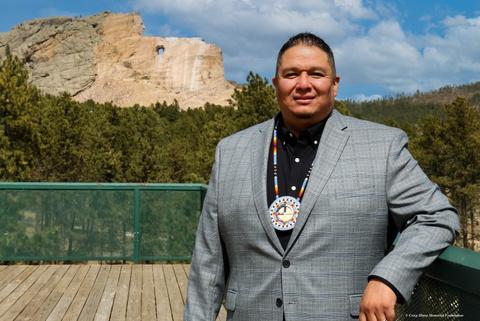
Whitney Rencountre II, is Crow Creek Hunkpati Dakota from the Crow Creek Sioux Tribe and is the CEO of the Crazy Horse Memorial Foundation. Whitney previously served as Associate Director and Instructor at The Indian University of North America®. Whitney was a 2019 Honoree of Western South Dakota Child Protection Council. He was named one of 605 Magazine’s South Dakota Young Leaders of 2017. Whitney served as Chairman of the South Dakota Humanities Council and Chairman of Visit Rapid City. For 11 years, he worked as Director of the Ateyapi Program, a culturally based mentoring program working with over 1,000 students each year in the Rapid City Area School District. Whitney has a passion to build bridges in the communities he serves.
Joseph A. Konkol is the Chief Financial Officer for the Foundation. Until he stepped into his current role, he served as the Interim CEO and Vice President of Finance at the Memorial. He has been at Crazy Horse Memorial® for over 25 years with expertise in financing and nonprofit accounting management. Prior to joining the Foundation, Joe served as the Payroll/Grant Accountant at St. John’s University in Minnesota. Joe earned a bachelor’s degree in Accounting at Southwest State University (now Southwest Minnesota State University) and passed the CPA exam in 1988.


Chief Mountain Officer, Dr. Caleb Ziolkowski has several degrees, a result of his love of learning through countless hours researching, writing, and problem solving. His advanced degrees are a MA in Law & Diplomacy from Tufts University and two from UCLA—a MS in Statistics and a Ph.D. in Political Science. From 2015-2022, Caleb worked on the Mountain Crew while earning his degrees from UCLA—he helped with technical analysis and planning while at school and, in the summers, worked fulltime on the Mountain. Caleb was on the path to becoming a professor—finishing a Postdoctoral Fellowship at Princeton and ready to start another at MIT—when the chance to serve as Director of the Mountain Carving arose. Faced with the choice to continue his career out east or move back to the Black Hills, he decided to be part of the legacy his grandfather began; he hasn't looked back since.
Mary Murtala, Chief Development Officer, is a highly experienced nonprofit executive skilled at leading teams, as she did in her most previous role as Senior Managing Director of Development at National Parks Conservation Association. Her decades of experience include other organizations such as the SEED Foundation and the University of Maryland, College Park. A collaborative and responsive leader, Murtala is a Tulane University graduate and an alumna of both the New Strategies Program for Nonprofit Executives at Georgetown University’s McDonough School of Business and the Nonprofit Executive Leadership Program at Indiana University’s Lilly Family School of Philanthropy.

AtCrazyHorseMemorial®weremainsteadfastintheresponsibilitiesofourmissionasagloballyrecognized humanitarianinitiative.OnefocalpointremainstheMemorialtoCrazyHorseitself,knownastheMountainCarving, thelargestongoingmountaincarvingintheworld.Wehavecompletedaboldfundraisinginitiative,theMountain Match,boostedbyagenerousanonymousdonorwhopledgedtomatchfundsraisedata2:1ratio.Thiseffort coveredthecostofanindustrialtowercraneandroboticarm-cutting-edgetoolsthatwillpropeltheMountain CarvingprojectforwardandenableustoadvancetheMemorial'sfutureusinginnovation.
Thetowercranewillfacilitatetheuseoflargerequipment,diminishingmanuallaborandexposuretohazards, ultimatelyenhancingthesafetyandwell-beingofourteaminthelongerterm.Coupledwiththeroboticarm,we anticipateproductivitytoincreaseuptothreetimesitscurrentrate,significantlyreducingtheproject'stimelineto completion.
Alongwiththetowercrane,theroboticarmwilltransformthecarvingprocessontheMountain.
Thecurrentcarvingprocesshasfourdistinctphases:Bulkrockremoval;roughshaping;contouring;andfinally, detailwork.Anindustrialroboticarmcanautomatethecontouringphaseanddosoinasafe,controlledway.A roboticarmwouldbebothfasterandmoreaccuratethancurrenttechnologyallowswithhumans manipulating finishingsaws.Whilemoving,mounting,andinitiatingtheroboticarmwillrequirehumanintervention,the planningandcuttingwillrequireminimalhumaneffort.ThisfreestheMountainCarvingCrewtofocusonthebulk rockremoval,roughshaping,anddetailworkphases.
Theweightoftheroboticarmwillbesubstantial-around15,000pounds!Itisnotfeasibletomoveitaroundthe Mountainotherthanbyatowercrane.Atowercranewillrevolutionizeaccess;roadsarenolongernecessaryto movelargepiecesofequipment.Additionally,beingabletorelyonlargerequipmentmeansmembersoftheCrew donothavetodothisworkmanually.Safety,longevityandhealtharealladditionalbenefits.
Images: Simulated visuals showcasing a robotic arm in action on the Mountain Carving, alongside the radius of a tower crane over the Mountain, compared to the radius of our current crane.
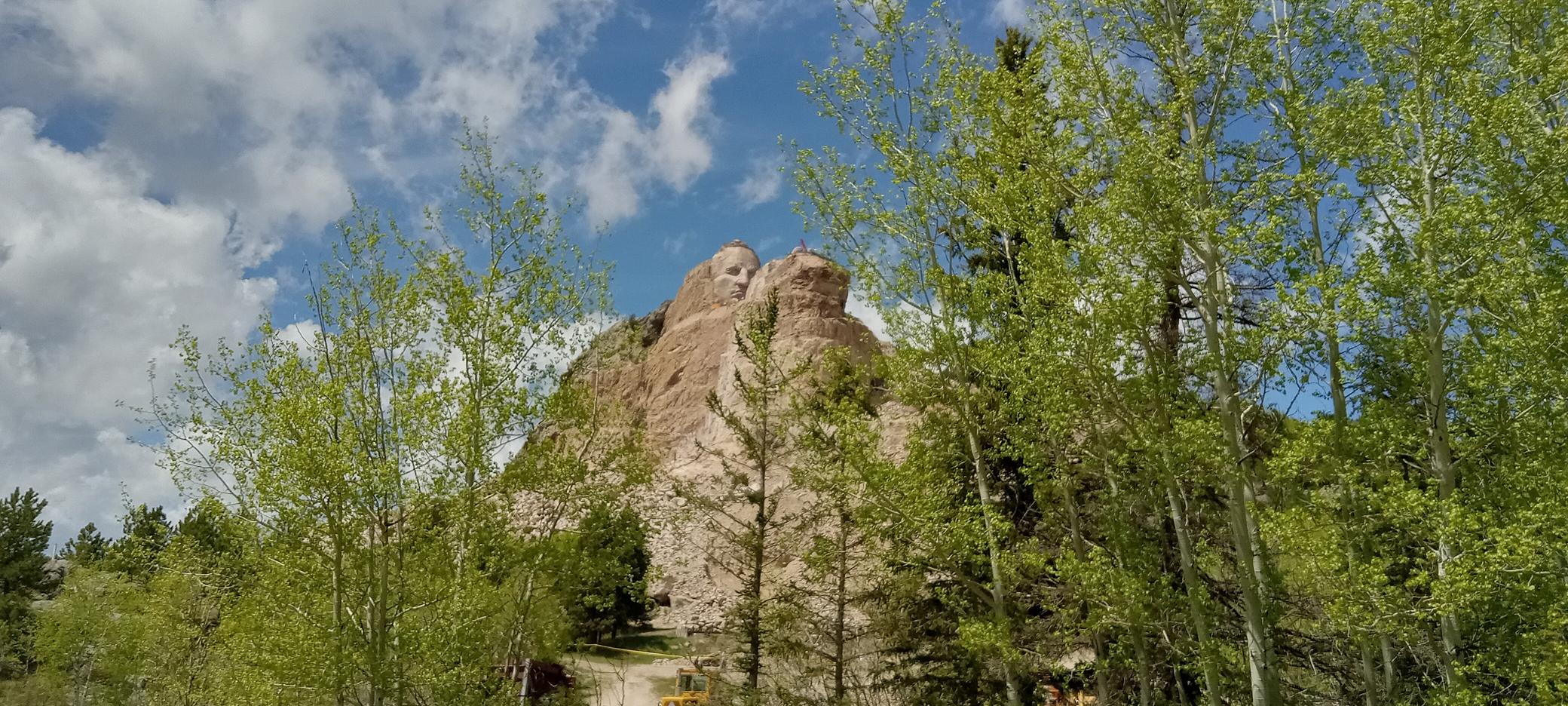
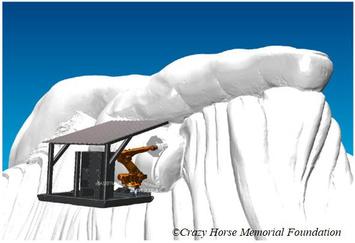



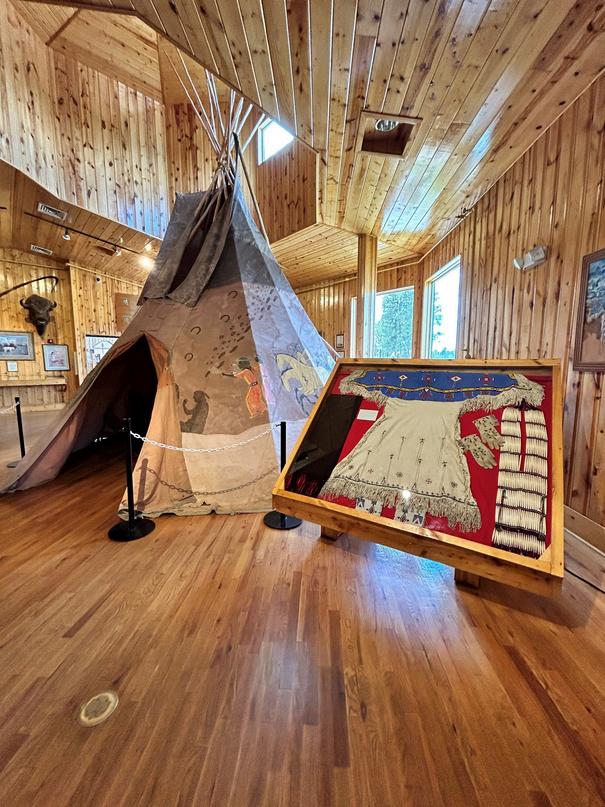
The Indian Museum of North America® began with a single exhibit donated in 1965 by Charles Eder (Sisseton Band of the Sioux Tribe/Dakota Nation). The impressive Charles Eder Collection is still on exhibit to this day. Since then, the Museum has grown to over 14,000 donated arts and artifacts representing the diverse histories andculturesofover300NativeNations.
In 2023, longtime friend and supporter of the Memorial, Gerald Forsythe, generously gifted another complete set of reproductions of David Humphreys Miller’s “Custer Survivors” artwork to the Museum. The set of 72 artworks were delivered to the Memorial at the beginning of 2024, and the Museum recently exhibited six of them for the first time to coincide with the anniversary of the Battle of Greasy Grass (the Battle of Little Bighorn). The new reproductions of Miller’s artwork feature a short biography of each warrior and a short excerpt from their interview with Miller. Together, the 72 new reproductions will help Museum staff tell the storyofGreaseGrassinawaythathasneverbeendonebefore.
The staff of The Indian Museum of North America® and Crazy Horse Memorial® extend their steadfast gratitude to all our gracious donors and recognize Gerald Forsythe for generously donating this special set of artworkstotheMuseumandlookforwardtofurtheringtheeducationalmissionoftheMemorialthroughthem.
The Museums of Crazy Horse Memorial® include The Indian Museum of North America®, The Native American EducationalandCulturalCenter®,theMountainCarvingGallery,andtheZiolkowskiFamilyLifeCollection.
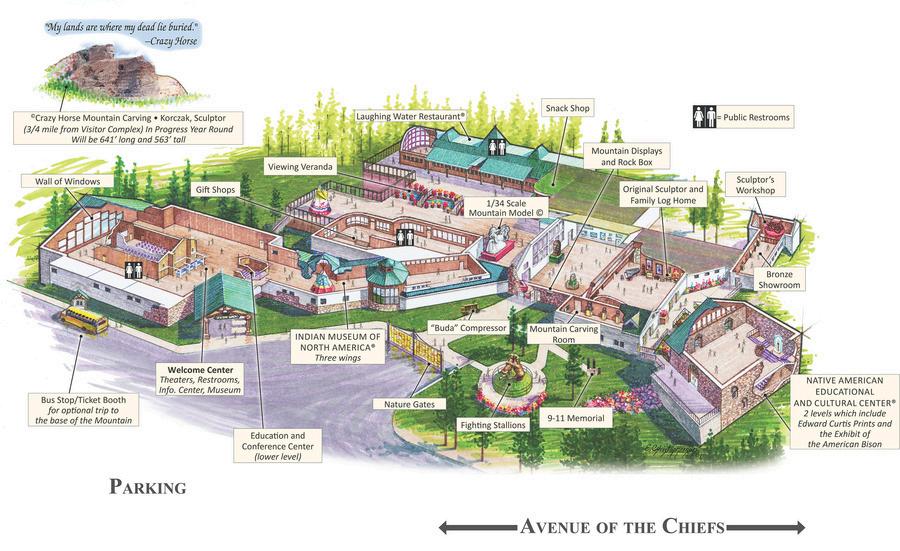

Crazy Horse Memorial Foundation is excited to welcome Dr. Gordon Ambrosino as the new Managing Director of Museum, Interpretation & Cultural Affairs of The Indian Museum of North America® at Crazy Horse Memorial®.
Dr. Ambrosino previously served as the Curator at the Plains Indian Museum within the Buffalo Bill Center of the West in Cody, Wyoming, bringing a wealth of experience and academic expertise to his role. He holds a Ph.D. from La Universidad de Los Andes in Bogotá, Colombia, along with a B.A. from Northern Arizona University. In addition to his curatorial work, Dr. Ambrosino is an Adjunct Assistant Professor in the Anthropology Department at the University of New Mexico. His extensive background includes positions as a NAGPRA Coordinator at the Maxwell Museum of Anthropology and Auburn University, as well as postdoctoral fellowships at the Los Angeles County Museum of Art, where he contributed significantly to the Art of the Ancient Americas Department.
Dr. Ambrosino's career is marked by a commitment to cultural preservation and education, demonstrated through his previous roles as a Collections Manager and Repatriation Specialist at the Field Museum in Chicago and as a consultant for archaeological and curatorial projects in Colombia. His diverse experiences, ranging from teaching to museum management, underscore his dedication to anthropology and the arts. As he continues to shape the narrative of Plains Indian culture, Ambrosino's work not only enriches the Museum but also fosters greater understanding and appreciation of Indigenous heritage.
“We are excited to bring Dr. Gordon Ambrosino to Crazy Horse Memorial Foundation to lead The Indian Museum of North America®," said Whitney A. Rencountre II, Crazy Horse Memorial® CEO. "Gordon’s experience at the Buffalo Bill Center of the West in Cody, Wyoming, along with his experience working with tribes, will be a great resource for the Memorial. The CHMF Board of Directors and Senior Executive Team look forward to working with him to ensure The Indian Museum of North America® continues to advance our mission.”
Dr. Ambrosino uses his ethical principles to guide his curatorial and educational work, upholding the same values of merit, inclusion, reciprocal benefit, and growth as those held by the Crazy Horse Memorial Foundation (CHMF) and drawing from his previous roles, he envisions designing, implementing, and providing strategic direction for vibrant curatorial and educational programs that foster enduring, mutually beneficial relationships with Crazy Horse Memorial®.
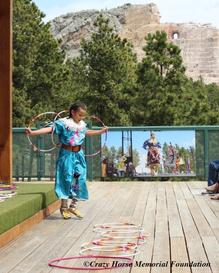
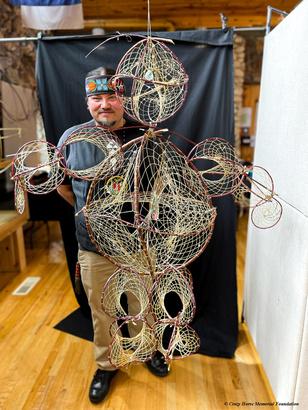



Cultural Programs at Crazy Horse Memorial® take place May through September annually, highlighting the living cultures of many North American indigenous tribes. Visitors look forward to a variety of artists, performers, storytellers, and culture bearers, both familiar favorites and new talents during 45minute presentations, seven times daily totalling nearly 800 unique experiences throughout the season.
From May to October each year, guests can explore the Native American Educational and Cultural Center® to engage with the Artists in Residence or participate in hands-on projects and demonstrations with artists from the Living Treasures program and collaborate on special hands-on projects with significant cultural meaning. Some examples include bead working, miniature deer hide shields, gourd dolls, dream catchers, clothespin dolls, and monotype demonstrations.
Additionally, the popular guided hike, Mahkoche Kin, takes place on select Fridays. Led by artist and Oglala Lakota College Faculty Member, Darrell Red Cloud, this educational one-mile walk explores the significance of Crazy Horse Memorial® in the Black Hills and its importance to the surrounding tribal nations. Mahkoche Kin offers a unique perspective on the Black Hills from an Indigenous viewpoint, sharing cultural insights from the Lakota People.
As always, these programs are no additional cost when you visit Crazy Horse Memorial®
Black Hills State University (BHSU) and The Indian University of North America® (IUNA) have announced a new undergraduate semester-long certificate program, Wichozani Health and Wellness. Focused on public health and wellness education tailored for Indigenous communities and emphasizing traditional healing practices, this certificate is designed for individuals interested in Indigenous tribal healthcare services and health-related programs. It promotes cultural sensitivity, an understanding of traditional healing methods, and addresses unique health challenges faced by Indigenous communities.
Notable courses of the program include “Native American Public Health,” “Ethnobotany of the Northern Plains,” and “Native Food Systems.” This certificate complements a wide array of majors and career paths in healthcare, biological sciences, nursing, American Indian Studies, and exercise sciences. Built on the partnership established by the Crazy Horse Memorial Foundation between BHSU and IUNA to offer higher education opportunities, it includes the 7TH GEN.® Undergraduate Summer Program, which supports Native students through immersive cultural and educational experiences. The program provides transferable credits to the student’s university of choice. The fifteenth7THGEN.®summerprogramrecentlyconcluded,markingthesecondconsecutiveyearofa100% completionrateamongenrolledstudents.
“This is another exciting piece of BHSU’s partnership with IUNA, and we are thrilled to contribute to academic programs that support Native students,” said Dr. Jon Kilpinen, provost at BHSU. “As we worked on ideas for a Spring certificate program, it was clear that a focus on Native health and wellness would fill a critical need. There are only a few certificate programs nationally that address Native health issues, and just a handful of those are intended specifically for undergraduate students.”


AngelLee,CheyenneRiverLakota,comesfrom theItázipčho, Mnikȟówožu,andHúŋkpapȟabands ofOčetiŠakówin.Shehas over20years’experienceworking inIndigenousEducation, integratingIndigenousLakotaKnowledge/Language and Westernscience,continuous schoolimprovement, accreditation, dataanalysis,and21stCenturyLearning.She hasservedatthe tribalcollege,K-12,tribal,andfederaleducationagency levels acrossherhomelands on CheyenneRiver.Forthepastthree years,Leehas hadoversight of the RapidCity AreaSchools OfficeofIndianEducationandTitleVI Program.Duringher timethere,sheservedinsenior leadershiprolesassistingthe district withtheIndigenous Education Task ForceandLakota LanguageImmersionPilotSchool.
Angel earned both a Baccalaureate of Science, Biology, and teaching credentials from Northern State University, as well as a Master of Arts in Education Administration and Lakota Leadership and Management. As a Doctoral student at Johns Hopkins University School of Education, she has focused her research on entrepreneurial leadership, equity, inclusivity, and cultural responsiveness, particularly in the realm of Indigenous education systems. She is certified as both an Advanced Teacher and Advanced Administrator. Her original lesson designs of integrating Lakota language, culture and history with her research in biochemistry and optical engineering have been showcased nationally.


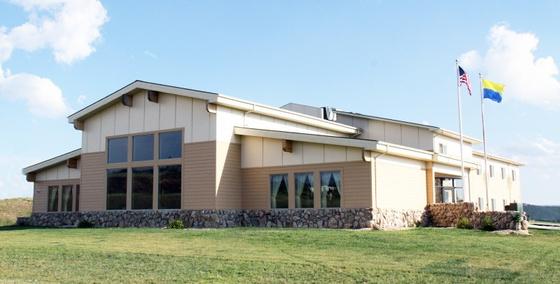

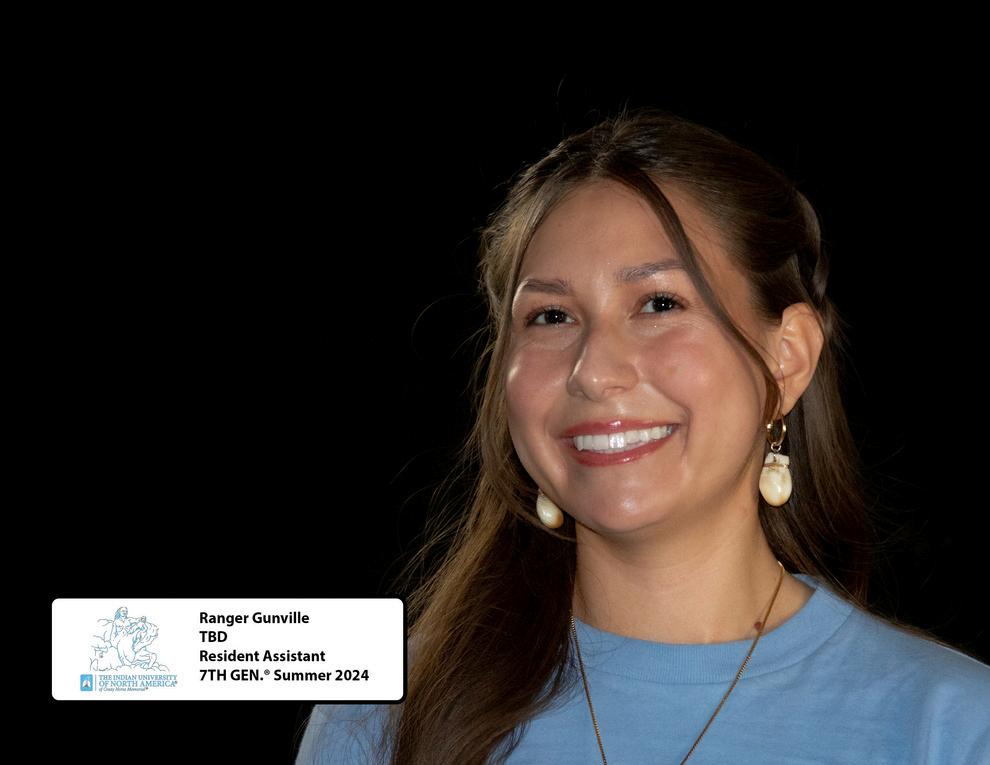
KadinWaln,fromtheRosebudSiouxTribe,wasafirstyearstudentinthesummer20247THGEN.®program. HewasthefirsteverinternfortheMountainfromThe IndianUniversityofNorthAmerica®.Hegainedmany worthwhileexperiences,includingbeingpartinalidar scanningprojectoftheoriginalwoodenbustofCrazy Horse.
KadinisattendingtheSouthDakotaSchoolofMines, pursuingaBSinElectricalEngineering.Heenjoyedhis internshipandtheknowledgegained,saying,“Working withtheMountainCrewtaughtmevaluableskillsthat canbeusedinfutureendeavors.”
RangerGunville,oftheCheyenneRiverSiouxTribe, servedastheAssistantManagerofResidenceLifefor the20247THGEN.®summerprogram,afterpreviously completingtwosemestersoftheprogram.Shewenton toearnherBSinVeterinaryTechnologyfromthe UniversityofNebraska-Lincoln.Ranger’snext educationalgoalisacceptanceintoveterinaryschool andhopestomakeacareeropeningapracticeinher homecommunitywithveterinaryservicesforsmalland largeanimals.Shehopestomentoryouthwhoare interestedinveterinarysciencejustasshehadbeen fromayoungage.
To date, over 400 students from 70 Native Nations and 29 states have successfully completed an academic program at The Indian University of North America® and continued their college studies at universities throughout the United States. Native students who start college at The Indian University of North America® are provided an unconventional level of student support from Student Success Coaches, regardless of where students pursue their degrees. In a recent survey of IUNA alumni, 72% of the respondents remained in college or had graduated. By comparison, in recent polling by Postsecondary National Policy Institute, the average college graduation rate of indigenous students is only 16.8%.